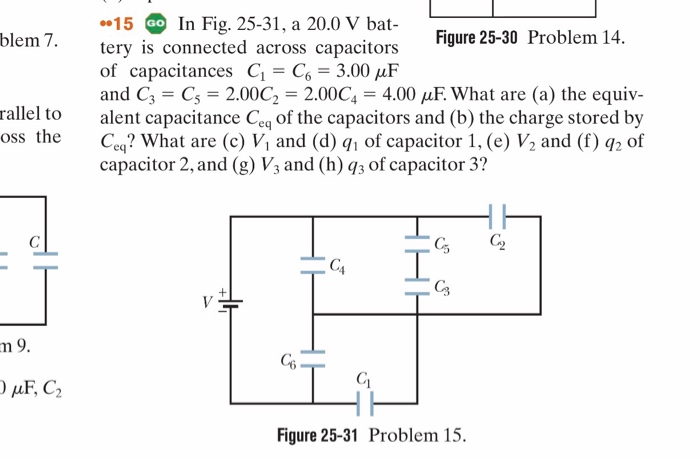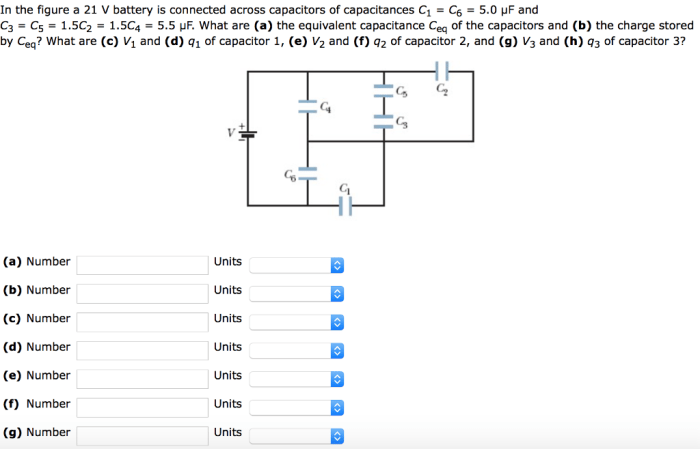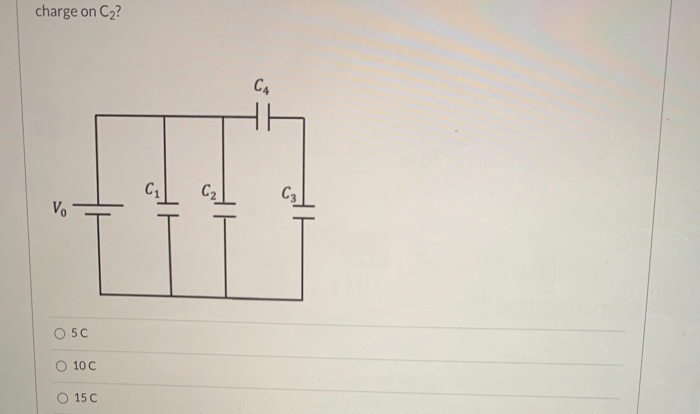What is the charge Q1 on capacitor C1? This intriguing question embarks us on an enlightening journey into the realm of electronics, where we delve into the fundamental principles of capacitors and unravel the intricate relationship between capacitance and charge.
Capacitors, ubiquitous in modern electronic circuits, serve as essential components for energy storage, signal filtering, and timing applications. Understanding the charge stored on a capacitor is paramount in comprehending the behavior of these circuits and unlocking their full potential.
Basic Concepts

A capacitor is a passive electrical component that stores electrical energy in an electric field. It consists of two conductive plates separated by an insulating material called a dielectric.
The function of a capacitor is to store and release electrical energy. When a capacitor is connected to a voltage source, it stores energy in the form of an electric field between its plates. When the capacitor is disconnected from the voltage source, it releases the stored energy back into the circuit.
The capacitance of a capacitor is a measure of its ability to store electrical energy. It is measured in farads (F) and is determined by the physical characteristics of the capacitor, such as the area of the plates, the distance between the plates, and the dielectric material used.
Charge on Capacitor C1: What Is The Charge Q1 On Capacitor C1

The charge on a capacitor is the amount of electrical charge stored on its plates. It is measured in coulombs (C) and is determined by the capacitance of the capacitor and the voltage across it.
The factors that determine the charge on a capacitor are:
- Capacitance (C): The capacitance of a capacitor determines its ability to store electrical charge. A capacitor with a larger capacitance can store more charge than a capacitor with a smaller capacitance.
- Voltage (V): The voltage across a capacitor determines the amount of charge stored on its plates. A capacitor with a higher voltage will have more charge stored on its plates than a capacitor with a lower voltage.
The equation for calculating the charge on capacitor C1 is:
Q1 = C1
V1
where:
- Q1 is the charge on capacitor C1 (in coulombs)
- C1 is the capacitance of capacitor C1 (in farads)
- V1 is the voltage across capacitor C1 (in volts)
Circuit Analysis

Capacitors play an important role in circuits by storing and releasing electrical energy. They can be used to smooth out voltage fluctuations, filter out unwanted frequencies, and provide timing functions.
To analyze the charge on capacitor C1 in a circuit, it is necessary to consider the circuit configuration and the voltage applied to the capacitor.
In a simple RC circuit, the charge on capacitor C1 can be calculated using the following equation:
Q1 = C1
- V0
- (1
- e^(-t/RC))
where:
- Q1 is the charge on capacitor C1 (in coulombs)
- C1 is the capacitance of capacitor C1 (in farads)
- V0 is the initial voltage applied to the capacitor (in volts)
- t is the time (in seconds)
- R is the resistance in the circuit (in ohms)
Applications of Charge on Capacitor C1
Understanding the charge on capacitor C1 has practical applications in various fields of electronics and engineering.
Some of the applications of charge on capacitor C1 include:
- Energy storage: Capacitors can be used to store electrical energy and release it when needed. This is useful in applications such as power backup systems and portable electronic devices.
- Filtering: Capacitors can be used to filter out unwanted frequencies from a signal. This is useful in applications such as audio filters and noise reduction circuits.
- Timing circuits: Capacitors can be used to create timing circuits. This is useful in applications such as timers and oscillators.
Essential Questionnaire
What is a capacitor?
A capacitor is a passive electronic component that stores electrical energy in an electric field.
What is the function of a capacitor?
Capacitors store electrical energy, filter out unwanted signals, and regulate voltage in electronic circuits.
What is the relationship between capacitance and charge?
Capacitance is directly proportional to the charge stored on a capacitor for a given voltage.
